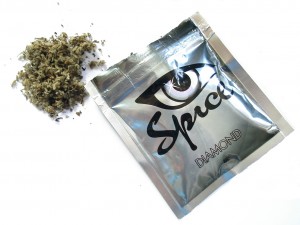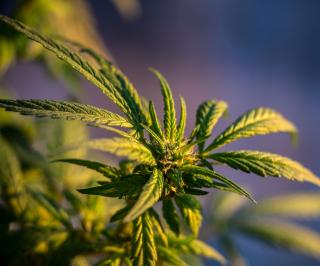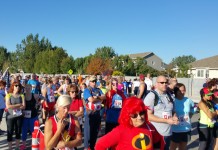What is Spice and How Dangerous Is It?

July 1, 2015 (Gephardt Daily) – We reported the story yesterday of an allegedly drug-addled Hispanic male who broke down the front door of a home at 460 S. 1000 West at around 11:45 a.m.
Detective Cody Lougy from SLCPD said the residents, a grandmother, mother, father and five children between the ages of three and seven, were watching TV. The male, who is described as in his 30’s and covered in tattoos, pounded on the front door and eventually broke it. The occupants took off running and barricaded themselves in a back bedroom.
At that time, the suspect went into the kitchen where he grabbed a 14-inch knife and pounded on the bedroom door. The suspect was yelling and not making a lot of sense, and the mother and father and grandmother were able to keep him from entering the bedroom. One of the children dialed 911. The suspect also pounded his head against the wall and speakers in the house, so there was blood inside the home.
Detective Lougy said it is thought the suspect may have been under the influence of a controlled substance, possibly spice.
The story left many of us wondering exactly what spice is, and how extremely it can affect individuals. A post from Drugabuse.gov said “spice” refers to a wide variety of herbal mixtures that produce experiences similar to marijuana (cannabis) and that are marketed as “safe,” legal alternatives to that drug. Sold under many names, including K2, fake weed, Yucatan Fire, Skunk, Moon Rocks, and others — and labeled “not for human consumption” — these products contain dried, shredded plant material and chemical additives that are responsible for their psychoactive (mind-altering) effects.
The website goes on to say that for several years, spice mixtures have been easy to purchase at gas stations and via the Internet. Because the chemicals used in spice have a high potential for abuse and no medical benefit, the Drug Enforcement Administration (DEA) has designated the five active chemicals most frequently found in spice as Schedule I controlled substances, making it illegal to sell, buy, or possess them. Manufacturers of spice products attempt to evade these legal restrictions by substituting different chemicals in their mixtures, while the DEA continues to monitor the situation and evaluate the need for updating the list of banned cannabinoids.
How Is Spice Abused?

Some spice products are sold as “incense,” but they more closely resemble potpourri. Like marijuana, spice is abused mainly by smoking. Sometimes spice is mixed with marijuana or is prepared as an herbal infusion for drinking.
How Does Spice Affect the Brain?
Spice users report experiences similar to those produced by marijuana—elevated mood, relaxation, and altered perception—and in some cases the effects are even stronger than those of marijuana. Some users report psychotic effects like extreme anxiety, paranoia, and hallucinations.
So far, there have been no scientific studies of spice’s effects on the human brain, but we do know that the cannabinoid compounds found in spice products act on the same cell receptors as THC, the primary psychoactive component of marijuana. Some of the compounds found in spice, however, bind more strongly to those receptors, which could lead to a much more powerful and unpredictable effect. Because the chemical composition of many products sold as spice is unknown, it is likely that some varieties also contain substances that could cause dramatically different effects than the user might expect.
What Are the Other Health Effects of Spice?
Spice abusers who have been taken to Poison Control Centers report symptoms that include rapid heart rate, vomiting, agitation, confusion, and hallucinations. Spice can also raise blood pressure and cause reduced blood supply to the heart (myocardial ischemia), and in a few cases it has been associated with heart attacks. Regular users may experience withdrawal and addiction symptoms.







